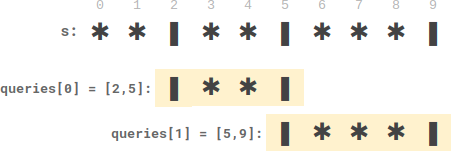You are given a 2D integer array items where items[i] = [pricei, beautyi] denotes the price and beauty of an item respectively.
You are also given a 0-indexed integer array queries. For each queries[j], you want to determine the maximum beauty of an item whose price is less than or equal to queries[j]. If no such item exists, then the answer to this query is 0.
Return an array answer of the same length as queries where answer[j] is the answer to the jth query.
Example 1:
Input: items = [[1,2],[3,2],[2,4],[5,6],[3,5]], queries = [1,2,3,4,5,6] Output: [2,4,5,5,6,6] Explanation: - For queries[0]=1, [1,2] is the only item which has price <= 1. Hence, the answer for this query is 2. - For queries[1]=2, the items which can be considered are [1,2] and [2,4]. The maximum beauty among them is 4. - For queries[2]=3 and queries[3]=4, the items which can be considered are [1,2], [3,2], [2,4], and [3,5]. The maximum beauty among them is 5. - For queries[4]=5 and queries[5]=6, all items can be considered. Hence, the answer for them is the maximum beauty of all items, i.e., 6.
Example 2:
Input: items = [[1,2],[1,2],[1,3],[1,4]], queries = [1] Output: [4] Explanation: The price of every item is equal to 1, so we choose the item with the maximum beauty 4. Note that multiple items can have the same price and/or beauty.
Example 3:
Input: items = [[10,1000]], queries = [5] Output: [0] Explanation: No item has a price less than or equal to 5, so no item can be chosen. Hence, the answer to the query is 0.
Constraints:
1 <= items.length, queries.length <= 105items[i].length == 21 <= pricei, beautyi, queries[j] <= 109
Solution: Prefix Max + Binary Search
Sort items by price. For each price, use a treemap to store the max beauty of an item whose prices is <= p. Then use binary search to find the max beauty whose price is <= p.
Time complexity: Pre-processing O(nlogn) + query: O(qlogn)
Space complexity: O(n)
C++
|
1 2 3 4 5 6 7 8 9 10 11 12 13 14 15 16 17 18 19 20 21 22 |
// Author: Huahua class Solution { public: vector<int> maximumBeauty(vector<vector<int>>& items, vector<int>& queries) { sort(begin(items), end(items)); map<int, int> m; int best = 0; for (const auto& item : items) { best = max(best, item[1]); m[item[0]] = best; } vector<int> ans; for (const int q: queries) { auto it = m.upper_bound(q); if (it == begin(m)) ans.push_back(0); else ans.push_back(prev(it)->second); } return ans; } }; |

